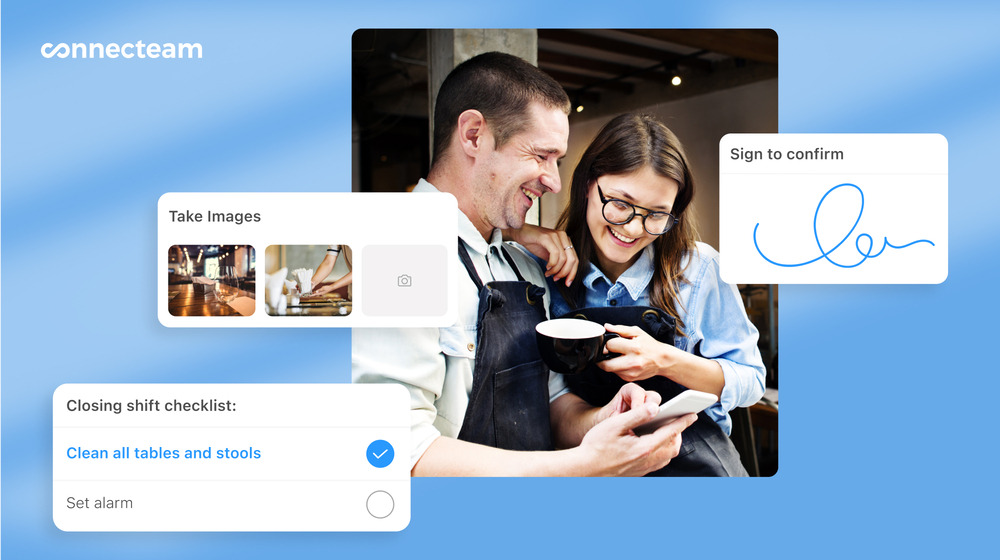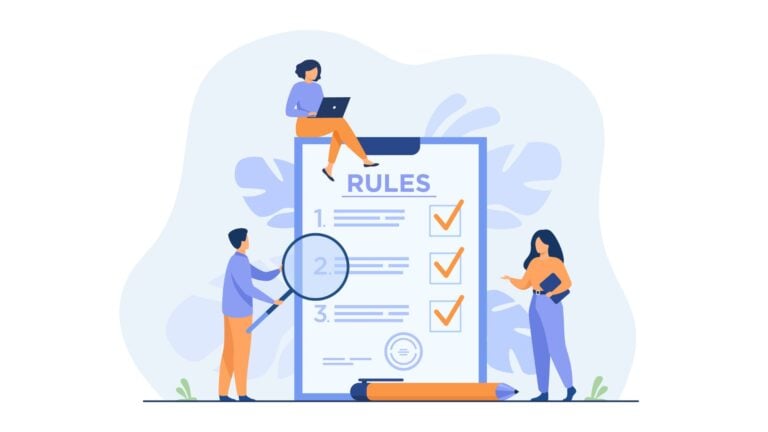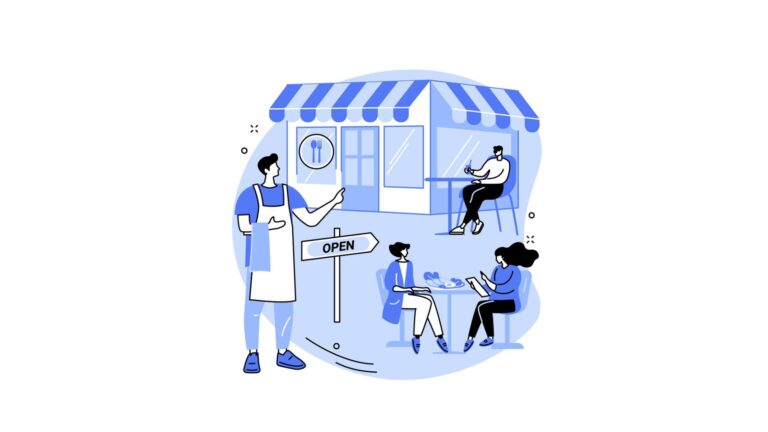Running a restaurant involves understanding various laws and regulations that differ based on your location. Knowing and following these restaurant laws and regulations is key to operating your business safely and responsibly. This guide covers the essentials you need to know—plus tips like creating a compliance checklist and using software like Connecteam.
Owning a successful restaurant requires you to understand various restaurant laws and regulations—from food safety guidelines to employment laws to alcohol service restrictions.
This can be challenging, but ignoring restaurant compliance isn’t an option. Non-compliance with labor laws or local ordinances can lead to expensive lawsuits and penalties. Meanwhile, failing to comply with food safety regulations can lead to temporary restaurant closures.
We’re here to help you avoid this. In this guide, we explain what makes up restaurant compliance. We look at the regulations common to most restaurants and share compliance tips to help you ensure your restaurant doesn’t fall short.
Key Takeaways
- Restaurant compliance involves many different regulations, which can vary by location. Understanding your local requirements is vital.
- Restaurant laws and regulations help restaurants provide their services safely and responsibly.
- Develop a comprehensive checklist to ensure you stay on top of the many areas subject to restaurant compliance.
- Staying compliant is easier when you use restaurant management software like Connecteam.
What Is Restaurant Compliance?
Restaurant compliance refers to your adherence to the local, state, and federal laws and regulations that dictate how you can run your restaurant business—whether you’re a large restaurant chain or a small business. These laws and regulations cover key elements, from handling food to paying your employees.
Why restaurant laws and regulations exist
The success of the restaurant industry relies on customers’ trust that your business is safe for them and your employees.
Restaurant laws and regulations aren’t meant to stifle your business. Instead, they help restaurants operate safely and responsibly.
Types of Restaurant Laws and Regulations
Below, we take a closer look at the different types of restaurant laws and regulations.
Food safety
Food safety is perhaps the most recognized part of restaurant compliance. It includes protocols for how food handlers should safely handle, store, and prepare food. It also regulates how your restaurant should serve food to prevent foodborne illnesses and ensure the health and safety of diners.
Many food safety regulations stem from the Food and Drug Administration’s (FDA’s) Food Code. This code provides guidance for food temperature, hygiene practices, food allergen management, and more. It serves as the foundation for many state and local government health codes.
Failing to follow food safety requirements can lead to foodborne illness reports. These will often result in customer complaints and inspections from local health authorities. If you’re found to have inadequate food safety processes in place, these authorities could order your restaurant to close until it can reopen safely. Usually, this requires you to pass a re-inspection.
Labor laws
Complying with labor laws is essential for fair and equitable treatment of restaurant employees. Compliance involves adhering to regulations governing minimum wage, overtime pay, work hours, meal and rest breaks, and child labor restrictions.
Many federal labor laws start applying to your business once your workforce grows beyond a certain number. For example, the Americans with Disabilities Act (ADA)—which requires you to accommodate employees with disabilities—applies to employers with 15 or more employees.
The Department of Labor enforces federal labor laws. Familiarizing yourself with the labor laws in your state is also important because legal requirements can vary based on your location.
Non-compliance with labor laws can result in stiff penalties like back pay and fines, as well as expensive employment lawsuits.
Fair treatment of customers
Anti-discrimination laws also apply to how you treat customers at your restaurant. For instance, the ADA requires that you provide equal access to all patrons, regardless of their abilities. This may require you to make accommodations in your restaurant environment, such as building an entrance ramp for wheelchair users.
Restaurants are considered public accommodations under the Civil Rights Act, which prohibits discriminating against customers because of their race, color, religion, or national origin. Adhering to these regulations ensures your restaurant fosters an inclusive, welcoming environment.
Mistreated patrons could take legal action against your restaurant.
Payroll practices
Accurate payroll practices involve maintaining meticulous records of employee work hours, wages, and benefits. It also means adhering to wage and hour laws—the federal and state laws that govern how you pay your employees. These include overtime pay and payroll tax requirements.
Payroll can be particularly tricky for restaurants because you often have multiple roles and varying pay types to work through. For example, restaurants can take “tip credits”—meaning they can use tips to cover a portion of their tipped employees’ wages. These are employees who customarily receive more than $30/month in tips.
But not following wage and hour laws and failing to ensure accurate payroll can lead to hefty fines, legal disputes, and damage to your restaurant’s reputation.
Did You Know?
Connecteam can help you streamline your restaurant payroll with automated time tracking and overtime management.
Occupational Safety and Health Administration (OSHA) regulations
OSHA regulations dictate workplace safety standards. Compliance with these regulations is key to maintaining a safe working environment for restaurant staff and minimizing workplace accidents and injuries.
One of the primary OSHA requirements is adequate workplace safety training. This training ensures your staff members know how to use equipment, prevent accidents, and cope with emergencies properly.
Failing to create a safe work environment for your employees can lead to hefty fines and potential shutdown of your restaurant if OSHA deems it unsafe.
Equal Employment Opportunity (EEO)
Ensuring compliance with EEO guidelines is fundamental to preventing discrimination and promoting inclusivity in your restaurant. These guidelines vary by state but include anti-discrimination laws related to hiring, promotion, and fair treatment of employees.
The Equal Employment Opportunity Commission (EEOC) enforces EEO laws nationwide. The EEOC investigates complaints of employment discrimination based on sex, race, color, religion, national origin, age, disability, or genetic information. Each state additionally has its own EEO enforcement agency and may have additional banned forms of discrimination.
Zoning and licensing
Restaurant owners must also navigate local zoning and licensing regulations that dictate where and how restaurants can operate. Zoning ordinances control the location and use of the property. Licenses are often necessary to operate a food business or legally serve alcohol.
Failing to maintain required permits might mean closing your business or stopping serving alcohol until you apply and receive a new permit.
This Might Interest You
Thinking about opening a restaurant? Read our guide on how to start a restaurant in 2025.
Examples of Restaurant Regulation Requirements
The restaurant regulations that apply to you will vary based on the size of your operations, number of employees, and business location. The examples below are a good primer for what you should expect.
Food safety
- Temperature control. Ensure food handlers store and cook food items at proper temperatures to prevent the growth of harmful bacteria. For example, keep refrigerators at or below 40°F (4°C), and ensure chefs cook poultry to at least 165°F (73.9°C).
- Handwashing and hygiene. Employees must wash their hands frequently and follow strict hygiene practices to prevent food contamination. Handwashing stations should be readily available.
- Allergen labeling. Accurately label and disclose the presence of common allergens in menu items, such as peanuts, tree nuts, dairy, soy, wheat, and shellfish.
- Cross-contamination prevention. Take steps to prevent cross-contamination of food items. For example, require food handlers to use separate cutting boards for raw meat and vegetables.
- Food storage. Store food items properly. For instance, label and rotate food to ensure food and beverage workers use older items first to prevent spoilage.
Labor laws
- Minimum wage. The Fair Labor Standards Act (FLSA) requires employers to pay workers a minimum wage of $7.25 per hour. You can pay tipped employees a minimum of $2.13 per hour if their tips will make up the difference to at least $7.25 per hour. Some states have higher minimum wage rates.
- Overtime pay. The FLSA requires you to pay eligible employees at least 1.5 times their regular hourly rate for hours worked over 40 in a workweek. Some states have different overtime calculation requirements.
- Child labor. Child labor laws often restrict the types of work, hours, and conditions employees under 18 can do. For example, minor employees may be unable to use some of the food processing equipment in your restaurant.
- Breaks. Your employees may be entitled to rest and break periods during their shifts. The FLSA doesn’t mandate this, but many state and local laws do.
Fair treatment of customers
- Accessibility. Follow the ADA’s specific requirements for businesses open to the public. For example, ensure that people with disabilities can access your restaurant, and let service animals into your restaurant even if you have a no-pets policy.
- Non-discrimination. Title II of the Civil Rights Act gives all people the right to the “full and equal enjoyment” of restaurant services. So, you must train your staff to treat all restaurant customers fairly.
Payroll practices
- Accurate payroll records. Your business must maintain accurate and complete payroll records, including hours worked, wages paid, and taxes withheld.
- Payroll taxes. You’re responsible for deducting and submitting payroll taxes for your employees. This includes federal and state income tax, social security, and Medicare contributions.
- Timely payroll processing. You must process payroll on time and pay employees as scheduled.
- Wage deductions. State and federal regulators limit permissible wage deductions for items like uniform costs or cash register shortages. Some states have very strict rules on the types of deductions that are acceptable.
Workplace safety
- Workplace safety training. Provide your employees with safety training to prevent accidents and injuries.
- Hazard communication. Maintain proper labeling of chemicals and hazardous materials, such as cleaning supplies.
- Emergency action plans. Develop and implement plans for emergency evacuations, fire prevention, and other emergency safety protocols.
- Personal protective equipment (PPE). Ensure that employees use appropriate PPE—such as gloves, masks, or safety goggles—when necessary.
- Workplace injury reporting. Report workplace injuries to OSHA or your local government authority and maintain records of such incidents.
EEO
- Non-discrimination. Prohibit discrimination based on characteristics like race, color, religion, sex, national origin, age, or disability in all aspects of employment.
- Disability accommodations. Make reasonable accommodations for employees with disabilities to ensure they can perform essential job functions.
- Harassment prevention. Implement policies and training programs to prevent and address workplace harassment.
- Equal pay. Ensure equal pay for employees performing similar work regardless of gender, race, or other characteristics.
Zoning and licensing
- Business licenses. Obtain the necessary licenses and permits to operate a restaurant in compliance with your local zoning and licensing regulations.
- Health department permit. Secure and maintain a health department permit to meet local sanitation and safety standards.
- Alcohol beverage license. If your restaurant serves alcohol, obtain the required liquor license and adhere to regulations governing alcohol sales and service. For example, you’re prohibited from serving alcohol to people under 21.
Restaurant Compliance Regulations Checklist
Creating a checklist for your restaurant is a useful way to ensure your business stays compliant.
Include all the topics below in your checklist, but customize them for your restaurant and location requirements.
Licensing and permits
Check that all necessary licenses and permits aren’t expired and that you’ve posted them where required.
Common licenses and permits you may need include:
- Business license.
- Food service establishment permit.
- Alcohol license (if you serve alcohol).
- Health department permit.
- Fire department permit.
Food handling and restaurant cleaning
Check that you have clear, complete policies and procedures for restaurant cleaning and the safe handling and storing of food.
You’ll likely need to have clear documentation for each of the following:
- Food handling processes and safety protocols.
- Proper food storage.
- Temperature control for food.
- Handwashing stations.
- Cross-contamination prevention.
- Cleaning procedures and rotation for standard and deep cleaning.
- Pest control measures.
- Allergen awareness.
Did You Know?
Connecteam’s Forms and Checklists feature can help you streamline your restaurant operation to meet food and health regulations with restaurant food safety checklists, restaurant kitchen cleaning checklists, kitchen operations checklists and many others to adhere to the highest hygiene standards of your business reputation and customers’ expectations.
Health and safety
You must have materials that help preserve a safe environment for your employees and customers. At a minimum, these should include:
- First aid kits.
- Fire extinguishers.
- Emergency exit signage.
- Smoke and carbon monoxide detectors.
- OSHA compliance logs to document any workplace incidents.
Employee training and documentation
You should maintain documentation of employee training and other employee details. Check that your documentation covers each of the following:
- Employee training details (include training dates and the training type provided).
- I-9 forms to document employee work authorization.
- Worker’s compensation program details.
- Employee policy handbooks.
Labor law compliance
Ensure your employee policies and payroll procedures align with the laws in your state. Your policies and procedures should cover:
- Minimum wage compliance.
- Tipped wage calculations.
- Overtime tracking.
- Anti-discrimination policies.
- Child labor law compliance.
- Meal and rest break compliance.
Did You Know?
Connecteam’s straightforward time tracking makes it easy to comply with labor laws in your state. Automatically track employees’ work time and breaks with accurate data that makes payroll a breeze.
8 Helpful Tips for Avoiding Restaurant Compliance Risks
Follow these tips to stay compliant with restaurant laws and regulations.
Stay informed
Keep updated with federal, state, and local laws and regulations that may impact your restaurant. Regularly check for updates and changes in laws.
Seek out an expert
Consult with an attorney or compliance expert specializing in the restaurant or food service industry to ensure you’re meeting all requirements.
Create a compliance checklist
Develop a compliance checklist that covers all aspects of your restaurant’s operations. It can be helpful to break your checklist into smaller, more detailed sub-checklists for different areas. For example, you might create a dedicated checklist for food hygiene.

Hire knowledgeable staff
Employ a team that’s already well-trained in food safety, or invest in robust training to bring new employees up to speed. Your managers should be familiar with employment law requirements and best practices.
Develop robust compliance protocols
Create various policies for staying compliant, and make these policies accessible to employees by keeping them in your employee handbook.
For example, create clear food safety and handling procedures. You can start by becoming familiar with the FDA Food Code, and then tailor your procedures to meet the needs of your restaurant.
Maintain accurate records
Keep detailed records of all permits, licenses, staff certifications, inspections, and any incidents. These records should be readily accessible for inspection. Inspections can come from your local health authorities, OSHA, or state employment agencies. Keeping your records organized will ensure you can reference what you need when you need it.
Conduct regular self-inspections
Schedule routine inspections of your restaurant to identify and address compliance issues before they become major problems.
You might handle this task yourself or delegate it to a staff member with compliance knowledge. Some restaurant owners even engage a local compliance expert to conduct inspections and provide reports with recommended improvements.
Stay up to date on employee training
Conduct regular staff training on safety, hygiene, and compliance topics. Ensure they understand and follow these practices consistently.
For example, if your restaurant serves alcohol, ensure staff members are well-trained in responsible service and age verification to prevent violations and accidents.
Help Keep Your Restaurant Compliant with Connecteam
Stay on top of restaurant compliance and commit to best practices with Connecteam. Our restaurant management software includes powerful features that simplify compliance. Here’s how.
Employee training and communication tools
Train your staff for compliance success from day one with Connecteam’s comprehensive employee training software.
Effortlessly create and manage customized training courses, from customer treatment to essential food safety training, to ensure compliance and skill development with minimal time and cost.
You can even monitor your employees’ progress and performance to ensure completion and understanding. Plus, you’ll have a detailed record of all mandatory training.

You can also stay in contact with your team with team instant messaging, which makes communicating training progress, policy updates, and compliance issues easy.
Digital forms and a company knowledge base
With our digital forms, which include checklists, you can ensure employees complete their assigned tasks, including health and safety assignments.
Pre-made templates make this easy. Our templates include restaurant cleaning, restaurant health inspection, and bar maintenance checklists. You can even require workers’ e-signatures on these checklists to ensure accountability.
In addition, your staff can quickly find the forms they need thanks to Connecteam’s in-app company knowledge base.
Employee scheduling, time tracking, and payroll
Scheduling restaurant staff in line with labor laws is also a breeze with Connecteam’s employee scheduler. You can set regulatory limits to avoid accidental overtime scheduling and other costly mistakes.
What’s more, Connecteam’s time tracking clock lets your employees punch in and out right from their mobile devices and tracks time down to the second.
In addition, you can instantly calculate overtime, breaks, and time off to ensure compliance with regulations. For example, our break management software lets you customize your employees’ breaks in accordance with your state’s meal and rest break laws.
Integrating Connecteam with your payroll provider is also simple. This way, you can pay your employees accurately for their time. Plus, you can easily maintain timesheets as payroll records.
Get started with Connecteam today.
FAQs
What does the FDA do for restaurants? Does the FDA inspect restaurants?
While the FDA is responsible for creating and updating food safety regulations, the organization doesn’t directly oversee restaurants’ adherence to these regulations. Rather, it assists the state and local agencies responsible for restaurant inspections. The FDA provides these agencies with training and program support. This way, the agencies can ensure restaurants are operating safely.
Why is it important for restaurant managers to know the law?
From modeling food safety to preventing harassment, your managers set the tone for your restaurant staff. By ensuring your managers know applicable laws and are committed to best practices, you can avoid costly mistakes and unsafe conditions.
The Final Word on Restaurant Compliance
Complying with the many laws and regulations that affect your restaurant isn’t a choice—it’s a necessity. While restaurant compliance can be a challenge, it helps you protect your staff and employees. In addition, the consequences of non-compliance can be even more daunting. Violations could lead to legal issues, fines, and even the closure of your restaurant.
The best steps to ensure your restaurant stays compliant are to become familiar with requirements, develop effective checklists, and use software like Connecteam.
Connecteam offers a range of tools that make restaurant compliance manageable. Stay on top of compliance requirements with communication and training tools, checklists, and employee management features.




